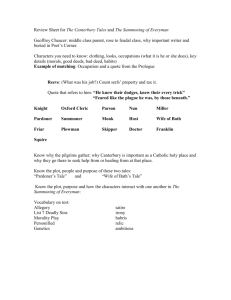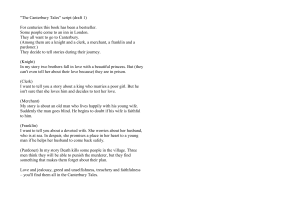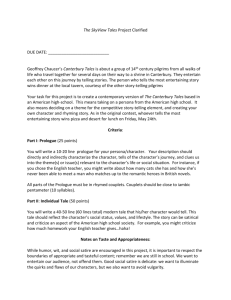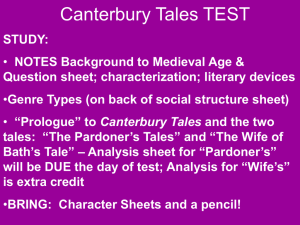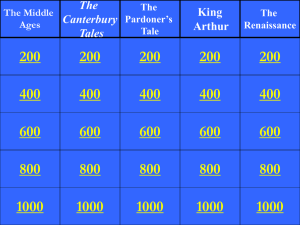The Canterbury Tales
advertisement
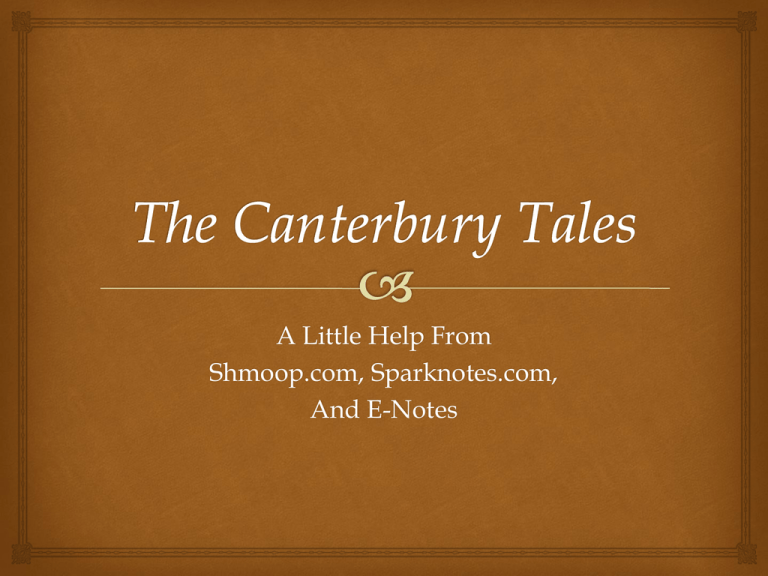
A Little Help From Shmoop.com, Sparknotes.com, And E-Notes Universal Themes Social class Authority Knowledge/education Rebellion/subversion Marriage/love/lust/fidelity Chivalry Human nature Religious virtue/martyrdom vs. religious corruption/hypocrisy Justice Revenge Redemption/salvation/damnation Divine power/the supernatural Fate/fortune Gender roles Motif A recurring pattern or a repeated action, element, or idea in a work of literature. Money/gold Animals Agricultural imagery The unfaithful wife The old man with a young wife The scholar vs. the tradesman The trickster that gets tricked himself The greedy, hypocritical clergyman Women as gossips Books (classical and religious literary allusions) Violence Superstition Dreams Rhyme and Meter A couplet is two lines of metered verse. In a rhyming couplet, the final words of the lines rhyme. A heroic couplet is a rhyming couplet in iambic pentameter. Most of The Canterbury Tales is written in heroic couplets. When in April the sweet showers fall And pierce the drought of March to the root, and all Rhyme Scheme A rhyme scheme is denoted by assigning an alphabet letter to each line of rhyming verse. Lines that rhyme are assigned the same letter. The rhyming couplets of The Wife of Bath’s Tale would be, chronologically, aa, bb, cc, dd, etc. If there were no authority on earth a Except experience, mine, for what it’s worth, a And that’s enough for me, all goes to show b That marriage is a misery and a woe; b For let me say, if I may make so bold c My lords, since when I was but twelve years old, c Iambic Pentameter An iamb is a pair of syllables, the first unstressed and the second stressed. Iambic pentameter consists of five iambs (ten syllables) per line. Iambic meter is common in English verse because the unstressedstressed rhythm occurs naturally in spoken English. The Canterbury Tales: General Prologue & Frame Story Summary The action begins at a tavern just outside of London, circa 1390, where a group of pilgrims have gathered in preparation for their journey to visit the shrine of St. Thomas Becket in Canterbury. The narrator, Chaucer, encounters them there and becomes one of their company. Chaucer describes all of the pilgrims in delightful, and often grotesque, detail. The Canterbury Tales The Canterbury Tales: Rules of the game The pilgrims go to dinner, during which the owner of the tavern, or Host, makes a proposal to the group: on the way to Canterbury, says the Host, each pilgrim will tell two tales, followed by two on the way back. The Host will accompany the group and serve as a judge of their tales. The pilgrim who tells the best tale wins a free dinner at the tavern at the journey's end. Should anyone question the Host's judgment, moreover, he has to foot the bill for the entire pilgrimage. The Canterbury Tales: The game in play Almost immediately, a pilgrim challenges the Host's authority. After the first tale, the Host asks the Monk to tell a tale, but the drunken Miller interrupts him and announces that he will speak next or leave the company. The Canterbury Tales: General Prologue & Frame Story Summary The pilgrims tell lots of different kinds of tales on their journey: comedies and tragedies, romances and dirty stories, and sermons and saints' lives, to name a few. Some pilgrims tell stories where a character with another pilgrim's occupation is humiliated in the course of the tale, which leads to trouble. The Canterbury Tales: The Ending The Canterbury Tales end after only 24 tales, a far cry short of the planned 120. We never get to see the pilgrims reach Canterbury, nor do we learn who wins the competition. It's likely that Chaucer ran out of time or energy. The Canterbury Tales as we know them end with the Parson's sermon on sin and repentance, followed by Chaucer's retraction. The Wife of Bath The Wife of Bath’s: Prologue •At this point, the Wife of Bath delivers a long, proto-feminist (or anti-feminist, depending on your point of view) diatribe. (For more about this, see Shmoop's guides to the "Wife of Bath's Prologue" and the "Wife of Bath's Tale.") Wife of Bath’s Tale Geoffrey Chaucer 's "Wife of Bath's Tale," found in The Canterbury Tales, is sometimes identified as a Breton lai, a genre of romance that originated in the region of Brittany in northwestern France. These lais were short narrative poems involving knights, ladies, and supernatural creatures and events. Feminism The events in "The Wife of Bath's Tale" are inspired by the Celtic folklore motif of the "loathly lady," in which a young knight must kiss or marry an ugly old woman, upon which she transforms into a more desirable form. Sometimes the point of the loathly lady story is to emphasize the importance of inner, rather than outer, beauty. "The Wife of Bath's Tale" nods to this in the loathly lady's long speech about the origin of gentility being within oneself rather than a result of one's lineage. The main point of the Wife's Tale is that women desire and should be granted sovereignty over their own bodies and minds. What is it about? In the long speech, she muses about poverty, age, and the origins of gentility. In fact, the loathly lady is probably meant as an alterego of the Wife of Bath. Like the Wife's relationship with her young husband Jankyn, the loath lady is an older woman who supposedly becomes delightful once her husband has yielded power to her. The Pardoner The Pardoner’s Tale: Prologue The Host asks the Pardoner to tell a tale of happiness or jokes. The Pardoner agrees, but says that first he will stop at a tavern by the roadside to eat cake and drink beer. The nobles in the company, afraid that the Pardoner's ingestion of alcohol will cause him to tell an R-rated tale, object and ask the Pardoner to speak about virtue and not sex. The Pardoner agrees, but says he must consider such a tale while he drinks. The Pardoner’s Tale The Pardoner describes a group of young Flemish people who spend their time drinking and reveling, indulging in all forms of excess. After commenting on their lifestyle of debauchery, the Pardoner enters into a tirade against the vices that they practice. First and foremost is gluttony, which he identifies as the sin that first caused the fall of mankind in Eden. Next, he attacks drunkenness, which makes a man seem mad and witless. Next is gambling, the temptation that ruins men of power and wealth. Finally, he denounces swearing. He argues that it so offends God that he forbade swearing in the Second Commandment—placing it higher up on the list than homicide. Assignment Two groups will study The Wife of Bath’s Tale Two groups will study The Pardoner’s Tale Groups will have three class periods to: Read the text, complete a reading guide, and plan a way to retell the story to the class…making sure that all of the main points are covered AND making sure that each person in the group speaks. 75 points: 25 points for reading, 25 points for answering the guide, and 25 points for retelling the story!
